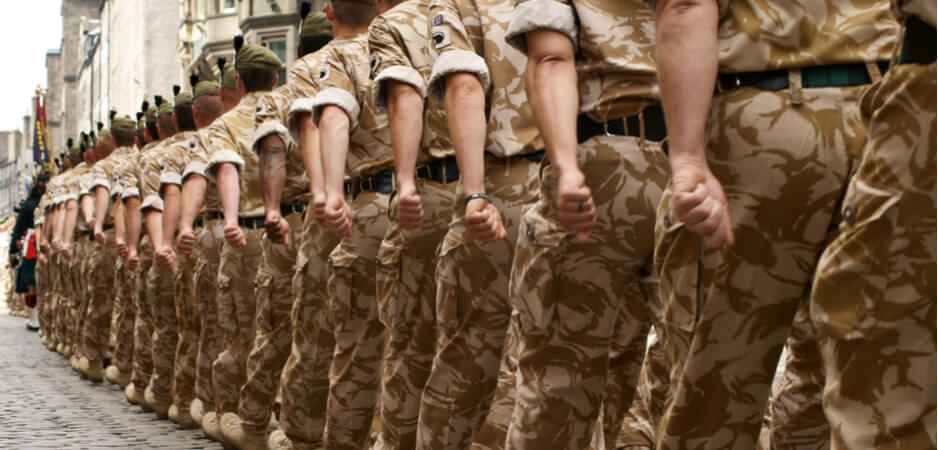The far right recognizes the value, both in training and in terms of access to arms and equipment, that active and former soldiers bring to its organizations.
In early October 2018, a photo emerged that showed former leader of the English Defence League, Stephen Yaxley-Lennon (aka Tommy Robinson) posing with a group of Army Cadets. The response was sizeable, with the Army launching investigations, and the UK government’s counter-extremism chief claiming that this was typical of the far right to target and co-opt the military and its symbols.
The question of why the far right seeks to develop and exploit military connections was explored by British Forces Radio program SitRep, in an interview I was lucky to be involved in at the time. It is important that we examine the historical incidents and figures from the far right who have attempted to use the military in similar ways, and understand that even though Tommy Robinson likes to present himself as being new and different, his behavior is very much an established form of activism by the British far right.
First of all, it is important to separate out three angles by which the far right approaches the military. The first is in copying its styles and structures, most starkly shown in the prewar period with the colored-shirt organizations like the Blackshirts, Brownshirts, the Silver Shirts, etc. This continued into the post-World War II period, with groups like the National Socialist Movement operating its Spearhead paramilitary force. We also saw attempts to do this legally in the postwar period, with Searchlight magazine reporting in February 1975 on how then-chairman of the National Front, John Kingsley-Read, had previously been involved in private military groups like the Frontiersmen who operated from rifle clubs in Britain.
The second is through the adoption of military heroes — and society’s reluctance to criticize them — to enable radical views to get a wider hearing. In Britain, we can look at figures like Admiral Sir Barry Domvile, one of the most senior establishment figures to be interned under Defence Regulation 18B. Admiral Domvile, who had supported the British People’s Party before the war and helped organize the pro-Nazi Anglo-German Fellowship, emerged from his postwar obscurity to lend his credentials to the National Front by joining its National Council upon its founding.
The third route includes the attempts by the far right to utilize the military as both a recruitment ground for those with military skills but also for possible access to weaponry, as well as a method to prepare themselves for the inevitable race war they felt was to come. More recently, we have seen this tactic emerge with National Action gaining a great deal of coverage in 2017, which was no doubt on the British Army’s mind when the picture of Tommy Robinson with its troops made the rounds.
Postwar Exploitation of the Army
In the immediate postwar period, with national service still in force, all able-bodied nationalists of a certain age would find themselves in the barracks at some point. As paper clippings in the Searchlight Archive show, the British Army was quick to discipline those who were seen to be engaged in barrack recruiting for the Union Movement in the early 1960s, with stories even hitting the national press on occasion. It is interesting that many of the Union Movement stories do focus upon the Parachute Regiment. Although there is insufficient material to truly explore this, it does raise some interesting questions about whether the regiment’s reputation for being one of the tougher outfits in the Army made it a target, or whether it was simply the luck of where Union Movement youth members would be posted.
There was, however, sufficient a concern to raise questions in Parliament. At the same time, Colin Jordan, of the National Socialist Movement, was said to find his best recruiting grounds at the Royal Marine Commando depot in Plymouth.
We see this story, notably around the Parachute Regiment, resurface after killings in Angola, where it emerged that the British officer recruiting mercenaries to fight against the communist forces was a disgraced member of the Parachute Regiment and the man handling security for a former member of Oswald Mosley’s Blackshirts. In July 1975, Searchlight further reported that one of the mercenary officers accused of mass executions was a former paratrooper who had been involved in one of the most infamous events of the Troubles in Northern Ireland, the Bloody Sunday massacre in Derry.
These revelations raised fears that there was a free flow of people with these radical-right ideas not just into the UK army, but that they were also putting their army expertise to use in their own causes across the globe. This followed on from earlier concerns after it emerged former youth members of the Conservative Party-linked group Monday Club were going to Southern Rhodesia to fight in the Bush War against black majority rule.
We can see from this how the far right attempted to exploit the military and its need for soldiers in the immediate postwar environment. With the imminent end of the British Empire and the beginning of the Cold War, the far right saw opportunity in this period of change and also in the fact it had people well placed by necessity within the military. When this didn’t come to fruition, we see in the moves to support the Bush War and the involvement in the conflict in Northern Ireland an attempt to put the resources the far right had gained in these failed infiltration attempts to good use. It moved on from the crisis of empire and found a new space in the remaining colonial-style conflicts.
Of course, this wouldn’t last. The coming intensification of the Cold War and the rising fear of racial violence at home, stoked by figures like Enoch Powell, led the far right to once again intensify efforts to infiltrate the military and pervert it for its own use. This fear of a coming “race war,” explored most famously in far-right fiction favorite The Turner Diaries, meant that it was important the far right was ready and prepared. It no longer had a cadre of young men fresh from the battlefields of Europe or the wars at the end of empire — the generation who just missed the war was increasingly middle aged.
Training New Cadres
Searchlight and the anti-fascist groups had grown concerned over the exportation of singular radical-right figures to Africa as mercenary soldiers — men who were chasing glory in attempting to thwart African self-rule. These concerns rather paled after it emerged, in 1976, that the officer placed in command of a small training cadre of two Territorial Army members and a unit of Army Cadets, all armed with live weapons, was himself a member of a far-right paramilitary group called Column 88.
The officer in question was not even quiet or secretive about his political affiliations or ambitions to use military means for far-right ends, having been a member of Spearhead, the paramilitary force of the National Socialist Movement, and having been convicted of two firearms offences in the 1960s. He used his position to arrange for his Army Cadet force to train alongside units of Column 88 and help spread military training and access to live firearms to the radical right.
Though initially denied by the UK Ministry of Defence when questions were raised in Parliament, just a day later apologies were issued to the House of Commons for these denials, and the officer in question was immediately discharged. Column 88’s success, however, contrasts rather starkly with efforts such as those by Tommy Robinson. Column 88 had avoided the more infamous and well known far-right personalities, just as previous clandestine far-right groups had tried (such as the National Socialist Group, for example) and instead went about their business quietly — although, it was claimed, with the tacit support of leading far-right figures.
We should not, however, exaggerate the influence or threat posed by such formations. A group that Searchlight estimated at 200-300 people led by a council of 13 was not likely to seriously challenge the British state, but the fact it was able to get into positions of command and access weapons was a wakeup call. This also echoed earlier concerns in the 1960s that ex-servicemen had been using military connections to funnel weapons to these previous military outfits like Spearhead.
National Action
These tactics were not isolated to Column 88 — although it is perhaps the most successful example — and there were coordinated attempts by National Front activists to utilize the Army in the 1970s. In Essex, it was reported that activists had made attempts to infiltrate Territorial Army units amidst a rise in local political violence in the area. In Chorley, Lancashire, stories emerged that the National Front had at least eight Army Cadets in uniforms helping them raise funds, giving displays of camping and cooking, and other survival skills to well over 100 National Front supporters.
Although in the case of Chorley it was suggested that the National Front had attracted the cadets’ involvement through duplicity by pretending to be a Methodist group, combined with the Column 88 revelations this was sufficient for the Army to begin a probe into the involvement of far-right groups, notably the National Front, with the Cadet Force and the Territorial Army Volunteer Reserve. These efforts continued over the years in various forms, recruiting former servicemen to run training camps for the youth or alternative scouting organizations focused far more around preparedness for some white nationalist uprising, as mythologized in The Turner Diaries or in its much later Colin Jordan-authored British variant, Uprising.
 The far more prominent event in recent history was the attempt by avowed neo-Nazi terror group, National Action. In 2017, a number of people, including some in the armed forces, were arrested for being members of the proscribed group. Notably, Lance Corporal Mikko Vehvilainen, a member of the Royal Anglian Regiment, was found to be actively attempting to bring other soldiers into the National Action group he was involved in. A believer in the race war theory, he had been stockpiling weapons — these included pump-action shotguns — for this coming fight and expressed a desire to create a National Socialist haven within several villages in Wales.
The far more prominent event in recent history was the attempt by avowed neo-Nazi terror group, National Action. In 2017, a number of people, including some in the armed forces, were arrested for being members of the proscribed group. Notably, Lance Corporal Mikko Vehvilainen, a member of the Royal Anglian Regiment, was found to be actively attempting to bring other soldiers into the National Action group he was involved in. A believer in the race war theory, he had been stockpiling weapons — these included pump-action shotguns — for this coming fight and expressed a desire to create a National Socialist haven within several villages in Wales.
Perhaps more worrying than his survivalist fantasies were his statements, which emerged during his trial, that he had groups of other soldiers within the Royal Anglian Regiment who were committed to National Action’s beliefs, and that he was overtly attempting to use their access as soldiers to gain equipment and uniforms. Despite the fact that another Royal Anglian soldier on trial with him was acquitted of membership of the terrorist group, he was discharged by the Army nonetheless, showing that it took Vehvilainen’s threats seriously.
Unfortunately, it would be easy to pick out more such examples over the years. It is clear that the far right in particular, and the radical right more broadly, recognize the value, both in training and in terms of access to arms and equipment, that active and former soldiers bring to their organizations. The fact that there is little success from these operations owes a lot to the investigations by the police, the military and the media that uncover these plots, but it is also clear that existing procedures at filtering can be subverted and worked around.
No system will ever be perfect. But, given the increasingly coded language of the radical right and the use of complex and dense ideological touchstone phrases that can easily pass as moderate speech, it is important that researchers of the radical right engage with the Army and other groups to help them properly understand this threat and ensure that the ideas and activism of the radical right do not spread to their ranks.
*[The Centre for Analysis of the Radical Right is a partner institution of Fair Observer.]
The views expressed in this article are the author’s own and do not necessarily reflect Fair Observer’s editorial policy.
Support Fair Observer
We rely on your support for our independence, diversity and quality.
For more than 10 years, Fair Observer has been free, fair and independent. No billionaire owns us, no advertisers control us. We are a reader-supported nonprofit. Unlike many other publications, we keep our content free for readers regardless of where they live or whether they can afford to pay. We have no paywalls and no ads.
In the post-truth era of fake news, echo chambers and filter bubbles, we publish a plurality of perspectives from around the world. Anyone can publish with us, but everyone goes through a rigorous editorial process. So, you get fact-checked, well-reasoned content instead of noise.
We publish 2,500+ voices from 90+ countries. We also conduct education and training programs
on subjects ranging from digital media and journalism to writing and critical thinking. This
doesn’t come cheap. Servers, editors, trainers and web developers cost
money.
Please consider supporting us on a regular basis as a recurring donor or a
sustaining member.
Will you support FO’s journalism?
We rely on your support for our independence, diversity and quality.






